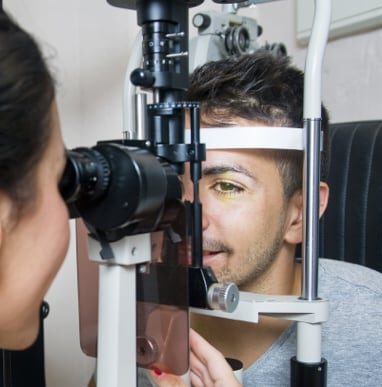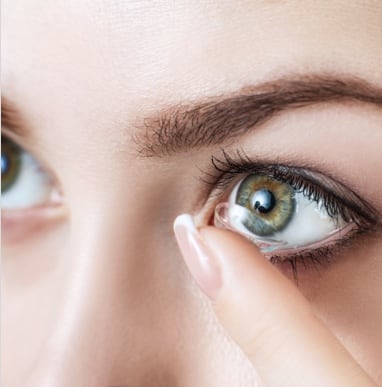Few things are as frustrating as experiencing headaches, dizziness, or difficulty visually focusing without being able to put a finger on what’s causing it. However, if you have, you may be one of many people who suffer from vertical heterophoria (VH).
Vertical heterophoria, also known as VH, is a binocular vision condition caused by a misalignment of the eyes due to differences in how each eye recognizes images.
Although VH is often misdiagnosed or left undiagnosed altogether, it’s a very real and treatable condition. Don’t worry if you’ve never heard of it before! Your optometrist can watch for signs during an eye exam and help answer your questions about this frustrating condition.
What Are the Symptoms of Vertical Heterophoria?
VH is what’s known as a binocular vision dysfunction (BVD). In this case, your eyes are vertically misaligned, causing unnecessary and ongoing tension between the brain and the muscles that control eye movement. Think of it this way: each of your eyes is seeing something slightly different, and your brain is clocking in overtime trying to make those images match.
The symptoms of VH vary, and there can be many of them! Sometimes, you may even go days without experiencing any at all. From visual and physical to difficulties thinking straight, common symptoms can include:
- Headaches
- Dizziness
- Eye pain
- Sinus pressure
- Nausea
- Eyestrain
- Difficulty with reading
- Double vision
- Fatigue
- Sensory overload
- Anxiety
Due to its often gradual progression and the varied nature of its symptoms, VH often goes undiagnosed. We suggest those suffering from these symptoms take some time to rest their eyes and visit their optometrist for proper diagnosis.

What Causes Vertical Heterophoria?
The exact cause of vertical heterophoria is not fully understood. Like other binocular vision dysfunctions, some experts suggest that it might be due to:
- An imbalance of the eye muscles
- Brain injuries
- Strokes
- Concussions
- Neurological disorders such as multiple sclerosis.
Additionally, some people have a congenital predisposition to the condition, which simply means they’ve had it since birth, but it may only start causing symptoms later in life.
How Does an Optometrist Diagnose Vertical Heterophoria?
The first step in diagnosing vertical heterophoria is for an optometrist to conduct a comprehensive eye exam. A simple vision screening likely won’t be able to diagnose VH, as they only test for 20/20 vision. During a comprehensive exam, however, your optometrist can evaluate your eye muscles and look for signs of underlying eye conditions. They may also use specialized equipment, such as lenses and prisms, to measure eye imbalances.
One of the key elements for diagnosing VH is assessing binocular vision. This is the eye’s ability to work together as a team, which is essential for clear, comfortable vision.
Once an optometrist makes a diagnosis, we can work with you to develop a personalized treatment plan.
What Could VH Be Mistaken For
VH, and binocular vision dysfunctions in general, have so many varied symptoms and people experience them differently that it’s common for people to be misdiagnosed. This is why, even though some people have VH from birth, they may not notice until they’re adults.
Conditions that vertical heterophoria could be mistaken for include:
- Migraines
- TMJ disorders
- Spinal misalignment
- Agoraphobia
- Anxiety
- ADHD
- Dyslexia
- Learning and development disorders
- Chronic fatigue syndrome
- Meniere’s disease
- Vertigo
If treatment for one of these diseases isn’t working, there’s a chance it may actually be vertical heterophoria. It’s not a guarantee, but it’s another reason why you should visit your optometrist annually!
How is Vertical Heterophoria Treated?
Since an imbalance between the eyes’ alignment and how they coordinate with each other usually causes VH, treatment may include training your eyes. This “training” is called vision therapy.
Vision therapy is a non-invasive treatment process that aims to improve the communication between the eyes and the brain. Vision therapy involves a series of exercises designed to improve coordination, tracking, and focus. These exercises are part of a personalized treatment plan designed by a trained vision therapist.
For example, vision therapy may include prism lenses. These lenses can manipulate the way light enters your eyes, potentially correcting the vertical misalignment that causes VH symptoms. Whatever your plan includes, your therapist can help you set goals and track your progress.
You Deserve to See Comfortably
Vertical heterophoria can be a significant source of discomfort for those who experience it. But it’s a treatable condition! The first step is proper diagnosis, but with patience and hard work, you might not have to suffer from its symptoms any longer.
If you feel dizzy, nauseous, or unsteady while walking, don’t hesitate to visit our Vision Care Center team for diagnosis and treatment options! We can craft a personalized vision therapy plan to help you see comfortably and regain your quality of life.
Remember, your health is your wealth, and taking good care of your vision is the first step to living a life with clear eyes.












